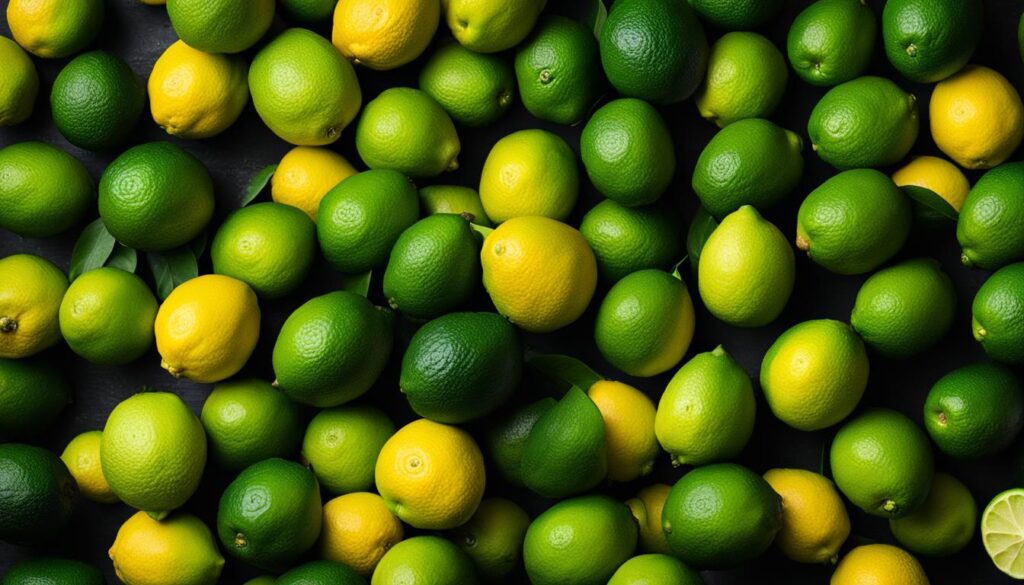When it comes to selecting limes, you want to ensure that you pick the freshest and juiciest ones. To make the right choice, there are a few factors to consider. Comparing the weight of the limes can give you a clue about their juiciness, as heavier limes tend to hold more juice. Look for limes that are brighter green in color, as they are likely riper and contain a higher juice content than darker ones.
Avoid limes with nipples on the end, as they typically have a thicker rind and produce less juice. A good way to gauge the juiciness of a lime is to give it a slight squeeze with your thumb. A juicy lime will give a little to thumb pressure and have a shiny, healthy skin.
It’s also important to note that key limes, while great for some recipes, are not ideal for juicing, especially in cocktails. When storing limes, keep them in the refrigerator for better longevity. Before juicing, it helps to warm them up a bit, as this maximizes their juiciness. Remember, fresh lime juice has a limited lifespan before it starts turning bitter, so timing is essential.
When to Pick Limes for the Best Results
Knowing when to pick limes can ensure that you enjoy them at their peak. One way to determine if limes are ripe is by their smell. Ripe limes will have a fresh, zesty lime smell, while unripe limes may not have much of a smell. Another indicator is the color of the limes. Most limes are green when ripe, but some types may turn fully yellow. Checking the skins of the limes can also provide insight. Ripe limes will be firm but not hard, and slightly squeezable. Limes that are too soft or too hard are not ripe enough or too ripe. Additionally, choosing limes that feel heavier indicates ripeness and a higher juice content.
Once you’ve picked the limes, store them properly to maintain their freshness until you’re ready to use them.
Green or Yellow Limes: Which is Better?
The color of limes, whether green or yellow, can impact their flavor and tartness. Green limes are typically underripe and have a more tart and acidic taste, making them ideal for adding a bite to recipes. On the other hand, yellow limes are fully ripe and have a juicier, less acidic, and sweeter flavor. The natural sugars in yellow limes have developed, resulting in a more pronounced lime flavor. While green limes are more commonly available in stores due to harvest and export requirements, ripe yellow limes offer a different taste experience.
It’s important to note that limes only ripen on the tree and cannot be ripened once picked. Therefore, it’s best to buy limes that are already ripe or mature to ensure the desired flavor.
When deciding between green and yellow limes for your recipes, consider the flavor profile you want to achieve. Green limes provide a tangy and bright taste, while yellow limes offer a sweeter and more balanced flavor. Experimenting with both varieties can add depth to your culinary creations.
Remember, whether you choose green or yellow limes, always opt for ripe and fresh ones to enjoy the best flavor and juiciness in your dishes.
Conclusion
Picking limes involves considering a few essential factors to ensure you select the freshest and juiciest ones. When selecting limes, pay attention to their weight, color, skin texture, and smell. The best limes are heavier, brighter green, without nipples, slightly squeezable, and have a shiny skin.
If you want to enhance the juiciness of your limes, store them in the refrigerator and warm them up before juicing. This simple step can make a significant difference in the flavor and juiciness of your lime juice.
When picking limes directly from the tree, rely on their smell and color to determine their ripeness. Green limes are known for their tart and acidic taste, while yellow limes offer a juicier, less tart, and sweeter flavor. To experience the variety of flavors limes offer, it’s important to enjoy them at their peak and try both green and yellow limes.
Next time you select limes, remember to consider their weight, color, skin texture, and smell. By choosing limes that meet these criteria, you can enjoy the freshest and juiciest limes possible. Don’t hesitate to experiment with different lime varieties and savor the distinctive flavors they bring to your culinary creations!
Can Pruning Sage Help Improve the Quality of Limes?
Pruning sage plant tips can indeed help improve the quality of limes. By trimming back the sage plant, you can promote better air circulation and sunlight exposure for the lime tree, which can lead to healthier and more flavorful fruits. Additionally, pruning can help control pests and diseases that may affect the lime tree’s productivity.










